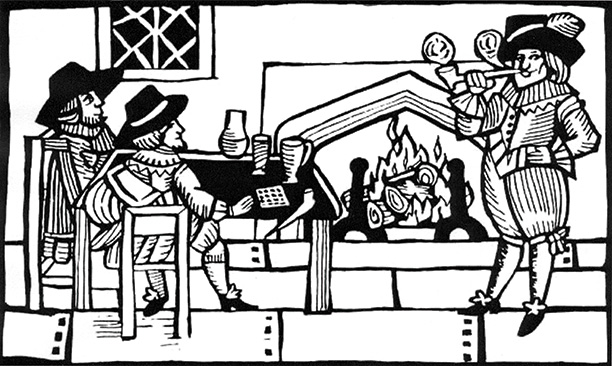A new project to analyse the Hearth Tax returns of early modern London and Middlesex offers a revealing portrait of a growing but divided city in the midst of cataclysmic crises. Vanessa Harding explains.
 Around the hearth: gentleman householders in a woodcut of the 1660sIn the spring of 1666 Londoners may well have felt that nothing was certain in their world except death and taxes. The previous year the worst plague epidemic in living memory had killed nearly 70,000 of the capital’s inhabitants. The total of weekly deaths had fallen steeply by the end of 1665, but half the capital’s parishes were still ‘infected’ and reporting plague fatalities in late December. Work to rehabilitate the city’s overfilled graveyards was ongoing and parishes and other institutions were struggling to put their records into order, following the deaths or desertions of office holders. Most citizens had returned, but business had not fully picked up and many merchants had suffered losses from the long quarantine on the movement of trade goods. However the requirements of the state could not be postponed. A fresh assessment and collection of the Hearth Tax, levied between 1662 and 1689 on each householder according to the number of hearths in their dwelling, was authorised for Lady Day (March 25th), 1666. Collectors produced new lists of householders and the number of hearths in every dwelling or workplace and annotated them with payment of the tax (one shilling per hearth), failure or refusal to pay, empty houses and certified exemptions. As a result we have a snapshot of the metropolis at a critical moment in its history, not long before the fire of September 1666 destroyed three quarters of the city centre, its business district and the heart of commercial activity.
Around the hearth: gentleman householders in a woodcut of the 1660sIn the spring of 1666 Londoners may well have felt that nothing was certain in their world except death and taxes. The previous year the worst plague epidemic in living memory had killed nearly 70,000 of the capital’s inhabitants. The total of weekly deaths had fallen steeply by the end of 1665, but half the capital’s parishes were still ‘infected’ and reporting plague fatalities in late December. Work to rehabilitate the city’s overfilled graveyards was ongoing and parishes and other institutions were struggling to put their records into order, following the deaths or desertions of office holders. Most citizens had returned, but business had not fully picked up and many merchants had suffered losses from the long quarantine on the movement of trade goods. However the requirements of the state could not be postponed. A fresh assessment and collection of the Hearth Tax, levied between 1662 and 1689 on each householder according to the number of hearths in their dwelling, was authorised for Lady Day (March 25th), 1666. Collectors produced new lists of householders and the number of hearths in every dwelling or workplace and annotated them with payment of the tax (one shilling per hearth), failure or refusal to pay, empty houses and certified exemptions. As a result we have a snapshot of the metropolis at a critical moment in its history, not long before the fire of September 1666 destroyed three quarters of the city centre, its business district and the heart of commercial activity.The London Hearth Tax project, funded by the Arts and Humanities Research Council (AHRC), is editing and publishing the returns for London and Middlesex for Lady Day, 1666, supplemented, where 1666 returns are lacking, by Hearth Tax records for the earlier 1660s.
Read the full text of this article in the current issue of History Today, which is out now in newsstands and on the digital edition for iPad, Android tablet or Kindle Fire.
No comments:
Post a Comment